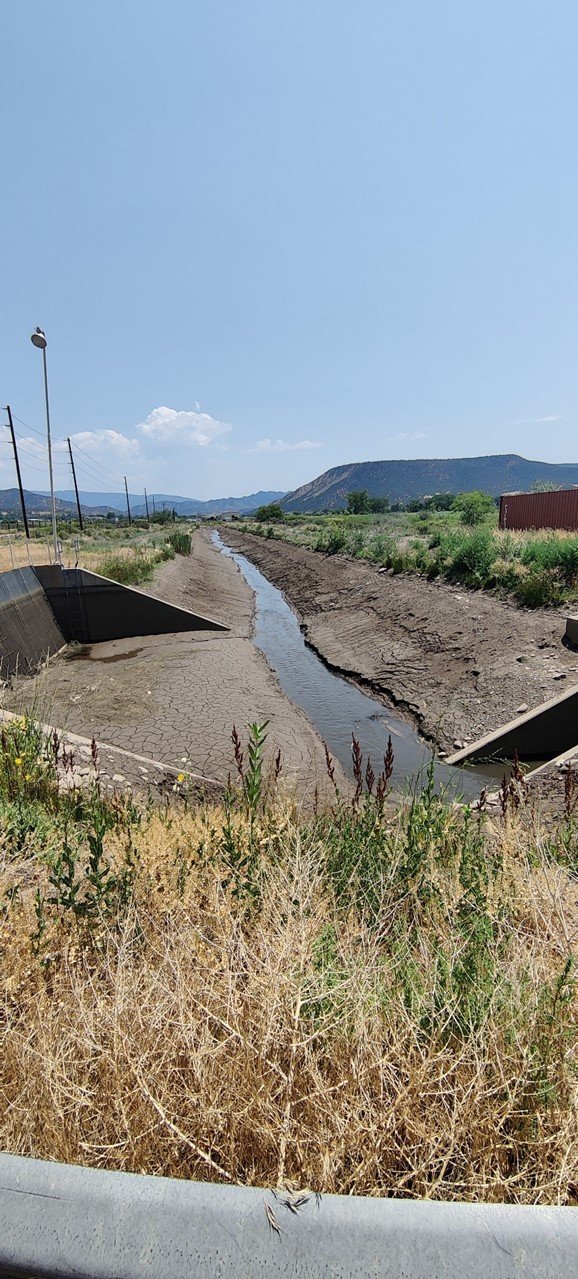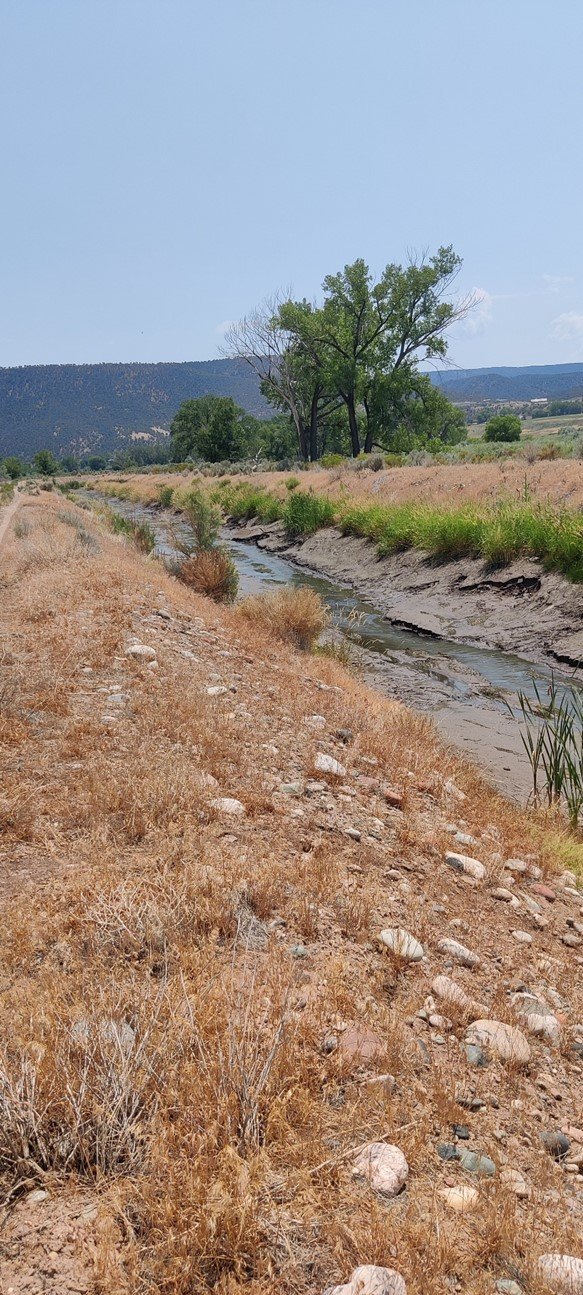The section of the Lower Pump Canal from the Colorado River to the Pump House. Section 1 is located between the Pump House and the first upstream bend in the canal where it enters a culvert as the access road crosses the canal. Section 2 is located upstream from Section 1 in the Lower Pump Canal, and runs from the terminus of Section 1 to the exit from the piped section from the Colorado River intake.
Silt Water Conservancy District Pump Canal Sediment Mitigation
Silt Water Conservancy District (SWCD) delivers irrigation water to users in the southern Silt Mesa area via the Pump Canal as part of a regional system. The main supply canal (Lower Pump Canal) diverts and conveys water from the Colorado River to the pump house which then pumps the irrigation water into the pump pipeline and canal to service the areas across portions of Silt Mesa. Increased sedimentation due to post fire debris and high sediment flows caused lower velocity flows in the Lower Pump Canal leading to algae blooms and system clogging.
Historically, management actions to clear the sediment and algae included manual dredging approximately every three to five years during the irrigation season (May-Sept). The increased sediment loading increased the need for manual dredging to a two to three-year time frame. SWCD needed to contract a long reach excavator to remove sediment from the Lower Pump Canal. The slower flows also increased the need for more frequent shutdowns for algae removal, thus negatively impacting water users in the service area. This project removed existing sediment within the SWCD canal and installed Best Management Practices (BMP’s) to capture and allow for future cleaning and removal of sediment and nutrients.
Initial dredging was completed during the 2021-2022 winter shutdown with a calculated depth of between 3 feet and 6 feet of accumulated material removed along the entire canal length. The Lower Pump Canal is wide and deep, so that any dredging operations for the entire canal required specialized long reach excavators with specific operators that must be hired by the SWCD. 11,577 tons of sediment volume were removed from the two sections prior to the 2022 irrigation season.
The sediment load in the Lower Pump Canal was measured during the last week of July 2022 during an irrigation water shutoff to dry and remove algae. A three-foot high rock structure was installed downstream of Basin 1 to capture sediment for easy removal. The Basin 1 location provides a feasible access location to use SWCD equipment and operators to remove sediment. 3,208 tons of sediment were captured during the first half of the 2022 irrigation season (May-July).
During the irrigation shutdown in July 2022, an increased berm of sediment was observed at the location designated as Basin 2 (see map) due to the slowdown of the water as it leaves the Colorado River intake pipe at a bend in the Lower Pump Canal. The potential sediment removal from this area was calculated and it was determined that easy access to this area would provide a feasible sediment removal location.
4,519 tons of additional sediment captured in Basin 1 and Basin 2 after the Pump Canal was shut down for the season in September 2022.
The access roads for both Basin 1 and Basin 2 were improved after the 2022 irrigation season to allow the SWCD personnel and equipment to remove sediment during future irrigation shutdowns. Historically these locations were too wet and soft for the SWCD excavator to reach the canal until the ground either dried (which can take up to a month) or froze in the winter. The improvements included over-excavating the existing material at the access locations and reconstructing the access road with geogrid material and large pit run, therefore stabilizing the access.
The total potential sediment that can be removed during any future shutdown of the canal at each Basin as a result of improved access and the rock structure at Basin 1 is 2,870 tons at both Basins.
It is anticipated that the bi-annual removal of sediment from the Basins will allow the SWCD to return to a five-year minimum schedule of cleaning on the entire Lower Pump Canal system rather than the two to three-year schedule observed in recent years. The rock structure BMP was successful in capturing sediment to be removed when the canal is shut down. The access basins described above will allow timely and efficient removal of sediment within the canal. Both Basin’s will allow SWCD to complete the work with their own equipment, instead of hiring a company with a long reach excavator, saving both time and money.
Nutrient Sampling
In addition, the rock structure will not only capture sediment but will also remove nutrients from the water and suspended solids. Implementation of the three-foot-high rock structure used to collect sediment is also contributing to the removal of nitrogen in the stream, acting as a baffle wall. The low permeability of the wall forces surface water to downwell into the streambed sediments (known as the hyporheic zone) which acts as natural biofilter for the canal. The sediments act as a filter and increase attenuation of contaminants, and microbial life living in the porous materials also feed on the nutrients in the stream.
In addition, the rock structure will not only capture sediment but will also remove nutrients from the water and suspended solids. Implementation of the three-foot-high rock structure used to collect sediment is also contributing to the removal of nitrogen in the stream, acting as a baffle wall. The low permeability of the wall forces surface water to downwell into the streambed sediments (known as the hyporheic zone) which acts as natural biofilter for the canal. The sediments act as a filter and increase attenuation of contaminants, and microbial life living in the porous materials also feed on the nutrients in the stream.
Other completed tasks with SWCD:
Sediment Removal from the Pump Sump: Sediment under the pump building was removed via vacuum excavation to decrease future sediment in the system. This also provides a clean starting point to measure the future sediment introduction into the system and evaluate the efficacy of BMP's installed upstream of the pump station. Brand X Hydrovac Services was able to remove all the sediment from under the pumps adjacent to the intake screen in two days.
Filter System for Pump and Bearings: The pumping plant utilizes a combination of pumps with a total of four available to lift the water from the Lower Pump Canal to the upper Pump Canal which then gravity feeds the Silt Mesa users. The pumps run continuously during the irrigation season with a small amount of instream flow being diverted for the lubrication system on each pump. The increased sediment in the water creates excess friction in the pump bearing which increases the wear on the pump shafts as well as the bearings. Pump number 1 was disassembled during the 2021-2022 winter shut down to replace the shaft after 5,000 hours of use, the intended service life on the shafts is 8,000 hours based on nominally “dirty” water. The filter system installed removes particles down to approximately 3 microns which will reduce the friction to such a level that the bearings and pump shafts will have an increased life cycle over the average 8,000 hours which is based on more standard irrigation water sediment loading.
Survey for Potential River Work: Bookcliff Survey Services completed a field survey of the intake flowline from the River to the Pump house including a section along the Colorado River. The survey also correlated the 1966 Bureau of Reclamation elevation datum at the pump house with the 1997 survey at the Colorado River intake. The survey data was processed and a map was created.
Potential Future Best Management Practices
The Lower Pump Canal intake system at the Colorado River was studied as part of the project for future potential BMP installation to mitigate increased sediment in the Pump Canal. The current intake (concrete box with slide gate) draws from the north channel of a split section in the river with the majority of the river flow running in the south channel. A cross channel barrier has been constructed downstream from the Pump Canal intake to allow the diversion of adequate water during low flow periods. This barrier creates a situation where sediment builds up behind the barrier during high flow periods and is then flushed into the canal during lower flows when most of the north channel is being diverted into the Pump Canal.
A potential upgrade to the intake system includes diverting more water into the north channel at the upstream split thus reducing the need for the Pump Canal to take all water and deposited sediment during low flow periods in the Colorado River. Modifying the channel split which occurs about 1-mile upstream will require significant permitting to perform any work on the main channel of the Colorado River.
The barrier across the north Colorado River channel can also be modified to reduce the amount of sediment build up behind the barrier, thus reducing the amount available to enter the Pump Canal. The design concept would be to create a barrier with a removable section or gate on the side directly adjacent to the Pump Canal intake that will create a high velocity flow in front of the intake. The intention being to flush the sediment built upstream of the barrier past the intake during high flows when the sediment may otherwise be deposited. This section/gate can then be closed during low flow situations to increase the Pump Canal intake. This BMP work will also require permitting to work within the Colorado River.





